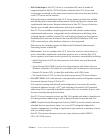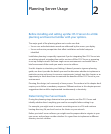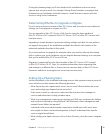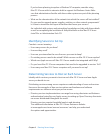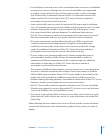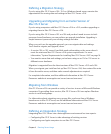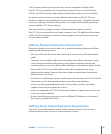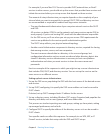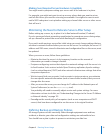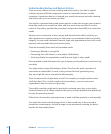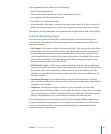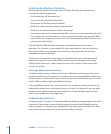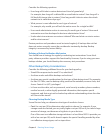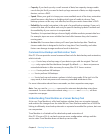
For example, if you use Mac OS X Server to provide DHCP, network time, or BootP
services to other servers, you should set up the servers that provide these services and
initiate the services before you set up servers that depend on those services.
The amount of setup infrastructure you require depends on the complexity of your
site and what you want to accomplish. In general, DHCP, DNS, and directory services
are recommended or required for medium and large server networks:
The most fundamental infrastructure layer comprises network services like DHCP Â
and DNS.
All services run better if DNS is on the network, and many services require DNS to
work properly. If you’re not hosting DNS, work with the administrator responsible
for the DNS server you’ll use when you set up your servers. DNS requirements for
services are published in the service-specic administration guides.
The DHCP setup reects your physical network topology.
Another crucial infrastructure component is directory services, required for sharing Â
data among services, servers, and user computers.
The most common shared data in a directory is for users and groups, but
conguration information such as mount records and other directory data is also
shared. A directory services infrastructure is necessary to host cross-platform
authentication and when you want services to share the same names and
passwords.
Here’s an example of the sequence in which you might set up a server infrastructure
that includes DNS, DHCP, and directory services. You can set up the services on the
same server or on dierent servers:
Setting up basic server infrastructure:
1 Set up the DNS server, populating the DNS with the host names of the desired servers
and services.
2 Set up DHCP, conguring it to specify the DNS server address so it can be served to
DHCP clients.
If desired, set up DHCP-managed static IP address for the servers.
3 Set up a directory server, including Windows PDC service if required, and populate the
directory with data, such as users, groups, and home folder data.
This process can involve importing users and groups, setting up share points, setting
up managed preferences, and so forth.
4 Congure DHCP to specify the address of the directory server so it can be served to
DHCP clients.
Your specic needs can aect this sequence. For example, to use VPN, NAT, or IP
Firewall services, include their setup with the DNS and DHCP setups.
30 Chapter 2 Planning Server Usage



